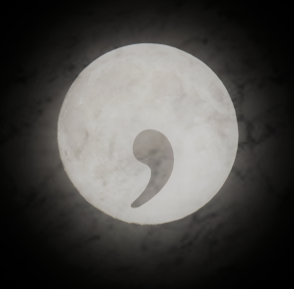The Comma: Tricky, Mysterious, and Subjective?

People often think commas are tricky and mysterious, and while they may be tricky if we aren’t familiar with the rules, they are not mysterious at all. They are not subjective, and no matter what your third-grade teacher told you, it’s probably not a good idea to place a comma wherever you feel the need to take a breath. What happens if you have a stuffy nose from a cold? Your essay might be littered with unnecessary commas.
There are actually some pretty clear-cut rules regarding commas, and while some rules seem to be clearer than others, at least in terms of how much most people understand, there are some basic comma rules that can help you know when and when not to use a comma.
With Coordinating Conjunctions
Use a comma with a coordinating conjunction when combining two independent clauses.
An independent clause is a term for a complete thought or sentence with both a subject and a verb. A coordinating conjunction is a conjunction that combines two equal elements and can combine two complete sentences. We have seven coordinating conjunctions in American English:
For
And
Nor
But
Or
Yet
So
You may have heard of these referred to as the FANBOYS, which is a great way to help you remember all seven of the coordinating conjunctions.
Coordinating conjunctions can connect all kinds of words and phrases, but when they are used to connect independent clauses, we must place a comma before the coordinating conjunction, as illustrated in the following example:
example
I am preparing for a zombie invasion, and I am building a strong zombie fort around my home.
Tip!
If the coordinating conjunction does not connect two independent clauses, you would not need a comma before the coordinating conjunction, as illustrated in the following example:
I am preparing for a zombie invasion and am building a strong zombie fort around my home.
In a Series

Use a comma to separate items in a series (three or more things).
You should even place a comma between the last two, although some writing style guidelines now omit this comma. In academic culture, we still use the serial or “Oxford” comma, so even punctuation rules have a rhetorical context. In some situations, you may not use the serial comma, but in academic writing you should, as illustrated in these examples:
example
She stayed up all night watching scary movies and ate popcorn, peanuts, and chocolate.
She ran into the house, shut the door, and locked all of the locks because she thought a werewolf was behind her.

With Introductory Phrases

Use commas after introductory words or phrases.
Subordinating conjunctions are words that connect, but unlike coordinating conjunctions, which connect equal parts, subordinating conjunctions connect dependent clauses (incomplete thoughts) to independent clauses. When you see a subordinating conjunction at the beginning of a sentence, this signals an introductory phrase, and you know a comma is coming at the end of that subordinate phrase, as illustrated in these examples:
example
Because his favorite team lost the Super Bowl, he would not speak to anyone about the game for two years.
Although they have stored a lot of food in their basement, I am not sure if they have enough for a zombie apocalypse.
Some of the most common subordinating conjunctions include the following:
common subordinating conjunctions
because
although
after
while
since
tip!
When these same phrases appear at the end of a sentence, they are not set off by commas, except in cases of strong contrast—for instance, in the case of the word although.
He would not speak to anyone about the game for two years because his favorite team lost the Super Bowl.
I am not sure if they have enough for a zombie apocalypse, although they have stored a lot of food in their basement.
You should also place a comma after introductory words, as illustrated in this example:
example
However, video games make great presents for a teenager.
Essential & Nonessential Information

Use commas in the middle of a sentence to set off words or phrases that are not essential to the meaning of the sentence.
example
The New York Yankees, who happen to be my favorite team, have won more World Series than any other team in baseball.
The Boston Red Sox, however, have won the World Series only seven times.
This rule can be a little tricky because of some misinformation we may have received at some point in elementary school. Were you ever taught that the trick to determining whether or not you need commas around information in the middle of a sentence was to pull out that information and see if the sentence was still complete? If the sentence was still complete, then you would know you needed a comma around that extra information.
Well, that doesn’t always work so well.
The best tip is to think about how meaning would be affected if you pulled out the word or phrase. If the meaning is not really affected, the word or phrase is not essential and should be placed inside a set of commas.
Conversely, it’s important to remember that essential words or phrases should not be set off with commas.
example
Her copy of Skyrim that I borrowed last week was the best game I have ever played and probably the best video game in the history of the world.
With Adjectives
Use a comma to separate coordinate adjectives describing the same noun.
An adjective is a word that describes a noun, and when we have two coordinate or “equal” adjectives describing the same noun, we need to place a comma between those adjectives, as illustrated in this example:
example
It was a stressful, sleepless night because I stayed up too late playing Dead Space.
If the adjectives aren’t coordinate, or “equal,” you should not separate them with a comma, as illustrated in this example:
example
Everyone knows the white frame house on Third Street is haunted.

A good trick to help you determine whether or not adjectives are coordinate is to try reading the sentence with the adjectives in reverse order or to add the word and between them. If the sentence would still make sense to you, the adjectives are coordinate, and you would need to separate them with a comma if they are describing a single noun.
Shifts at the End

Use a comma to separate coordinate elements at the end of a sentence or to indicate a distinct shift at the end of a sentence.
This comma rule is pretty straightforward. If you have a distinct shift at the end in content or a shift at the end for emphasis, you should set off that shift at the end with a comma.
examples
You want me to fight Chuck Norris for you? I am brave, not crazy.
You are going to stand in line for the new Halo 4, aren’t you?
With Quotes

Use a comma between the main discourse and a quote.
Whether you are writing dialog or setting up a quote from a source in your research essay, you should use a comma to separate the main discourse from your quote.
examples
As Bilbo Baggins said, “I like half of you half as well as I should like, and like less than half of you half as well as you deserve!”
My favorite line in Shakespeare’s Macbeth is when the witches say, “Double, double, toil and trouble; fire, burn; and cauldron, bubble.”
Places & Dates

Use commas to set apart geographical names and to separate items in dates, except for between the month and the day.
example
When I heard zombies had been located in New York, New York, I knew it was time to move to Los Angeles, California.
It is a good thing that letter made it to 4 Privet Drive, Little Whinging, Surrey, England.
I know the Mayan calendar indicates the end of the world on December 21, 2012, but I am going to stick with Nostradamus because he gave us until 3797.
Comma Abuse

Finally, don’t abuse the poor comma. It hasn’t done anything to you. Well, it may have caused you some stress from time to time, but you should not abuse it. You should definitely not use a comma in the following instances:
- To separate a subject from a verb.
example
My zombie plan, involves the complete and utter failure of your zombie plan.
2. Between two verbs or verb phrases in a compound predicate.
example
Do those vampires really sparkle in the sunlight, and drink only animal blood?
3. Between two nouns or noun phrases in a compound subject.
example
Aggressive newbies, and campers are ruining the gaming experiences for me.
4. To set off a dependent clauses at the end of a sentence, except in cases of strong contrast.
example
My gaming confidence is at an all-time low, because I got pawned ten times by a second grader.
Tips from the Professor
Students often struggle with commas when it comes to using them correctly with the coordinating conjunctions—and, but, or, for, nor, so, and yet.
The important thing to remember is that you have to keep in mind what else is around that conjunction. You can’t assume that every time you use and you’ll need a comma. Sometimes, you will, and, sometimes, you won’t.
In the following interactive video, the Grammar Professor will explain more about why you have to think about what surrounds your coordinating conjunction before you can decide whether or not you need that comma.












